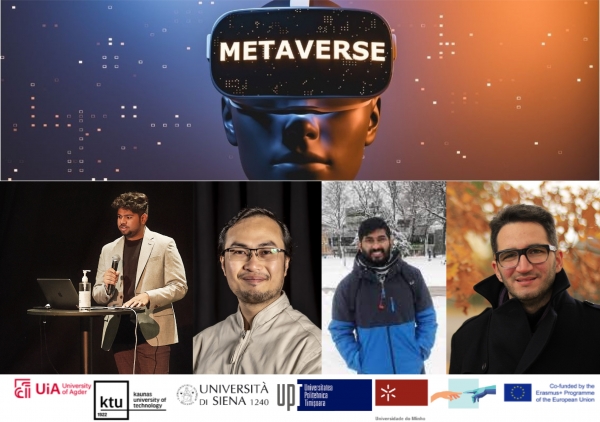Teaching Motion Control in Mechatronics Education Using an Open Framework Based on the Elevator Model
A new paper has been published in the journal of Robotics. The selected article is:
-
Filippo Sanfilippo, Martin Økter, Tine Eie and Morten Ottestad. Teaching Motion Control in Mechatronics Education Using an Open Framework Based on the Elevator Model. Machines 10(10), 2022. URL, DOI BibTeX
This work was supported by the Top Research Centre Mechatronics (TRCM), University of Agder (UiA), Norway.
I really thank all my co-authors and I congratulate all of them for their contribution.
University of Agder (UiA) Collaborative Robots team presenting at TIGHT - Tactile InteGration for Humans and arTificial systems (III Edition) IEEE RO-MAN 2022
I am very glad that our team, UiA - University of Agder, UiA - Mechatronics / Mekatronikk, Collaborative Robots team, is going to participate to TIGHT - Tactile InteGration for Humans and arTificial systems (III Edition) IEEE RO-MAN 2022, Full Day Workshop Hybrid format, Sept. 2nd, 2022.
Abstract
During the COVID-19 pandemic, social and work activities have become mostly virtual, and haptic interaction with people (and things) have become in most cases impossible, due to lock-downs and limitations. In addition, even when possible, fundamental communication gestures like hugging, or shaking hands are now perceived as dangerous in view of the spread of the contagion. Haptic technologies may play a key role in helping us regain the haptic communication channel. In this workshop, we will discuss how new tactile communication interfaces and paradigms can be exploited in human-human interactions to convey emotions, guidance, and confidence, with a focus on visually impaired users. Part of the workshop will be devoted to applications of tactile communication in human-robot collaborative and assistive scenarios. In fact, in the last 10 years, especially with the advent of wearable technologies, it has been shown that haptic feedback plays an important role also in interfacing humans with robotic devices. Going beyond sensory substitution in teleoperation tasks, where the haptic interface feeds back the force exerted by the robot on a remote environment, wearable interfaces enable new uses of haptic feedback. When adopted in conjunction with assistive and collaborative robots, for example, tactile alerts or acknowledgments (e.g., ad-hoc designed vibration patterns) can increase the mutual understanding between the human and the robotic agents. Speakers with different backgrounds will talk about advantages and disadvantages of exploiting the tactile channel to transmit information in human-human and human-robot interactions, focusing, in particular, on the neuroscientific and technological challenges that derive from the use of wearable haptic interfaces.
Talks presented by our team
- Filippo SanFilippo - A Haptic-enabled Framework for Hands-on e-Learning to Facilitate Safe, Digital Access to Laboratories in the Metaverse
- Saishashank Balaji - A Multimodal Training and Prototyping Simulator for Users with Sensory Processing Difficulties for VR/AR/XR Applications
- Minh Tuan Hua – A Low-Cost, Wearable Wireless Haptic Device for Human-Robot Collaboration
- Hareesh Chitikena – Human Robot Coexistence in Search and Rescue: An Ethical Perspective Framework
Some of the results presented are part of the AugmentedWearEDU project, which includes the following partners:
- UNIVERSITA DEGLI STUDI DI SIENA, Italy
- UNIVERSIDADE DO MINHO, Portugal
- UNIVERSITATEA POLITEHNICA TIMISOARA, Romania
- KAUNO TECHNOLOGIJOS UNIVERSITETAS, Lithuania
Forward leap into the metaverse: integrating VR/AR and haptics in STEM education
Our work has been selected by the editors as the cover of the forthcoming issue of the Robotics journal.
Cover Story (view full-size image): With the introduction of the metaverse, the virtual digital world is going to take a conceptual leap forward. As technology progresses, bringing us new immersive worlds, we must adapt how we educate students and equip teachers to face these new challenges. In this perspective, hands-on laboratory work and practical experience are currently under-supported. This is especially crucial in science, technology, engineering, and mathematics (STEM) subjects. In this work, a unique strategy to attain multisensory learning in STEM education by combining virtual and augmented reality (VR/AR) with haptic wearables is proposed. The implications of this novel viewpoint on established pedagogical notions are discussed. The goal is to support initiatives throughout the world to make fully immersive, open, and remote laboratory learning a reality. View this paper
This research was funded by the European Union through the Erasmus+ Program under Grant 2020-1-NO01-KA203-076540, project title Integrating virtual and AUGMENTED reality with WEARable technology into engineering EDUcation (AugmentedWearEdu), https://augmentedwearedu.uia.no/. This work was also supported by the Top Research Centre Mechatronics (TRCM), University of Agder (UiA), Norway.
I really thank all my co-authors and I congratulate all of them for their contribution.
Filippo Sanfilippo


